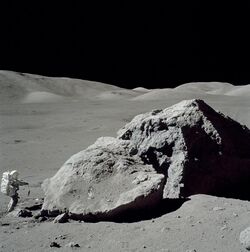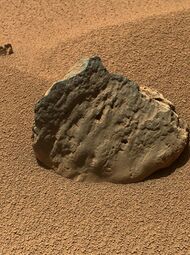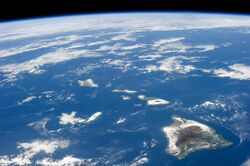NASA research
Topic: Astronomy
 From HandWiki - Reading time: 6 min
From HandWiki - Reading time: 6 min

Since its establishment in 1958, NASA has conducted research on a range of topics. Because of its unique structure, work happens at various field centers and different research areas are concentrated in those centers.[1] Depending on the technology, hardware and expertise needed, research may be conducted across a range of centers.[2]
Aeronautics
Medicine in space
A variety of large-scale medical studies are being conducted in space by the National Space Biomedical Research Institute (NSBRI). Prominent among these is the Advanced Diagnostic Ultrasound in Microgravity Study, in which astronauts (including former ISS Commanders Leroy Chiao and Gennady Padalka) perform ultrasound scans under the guidance of remote experts to diagnose and potentially treat hundreds of medical conditions in space. Usually there is no physician on board the International Space Station, and diagnosis of medical conditions is challenging. Astronauts are susceptible to a variety of health risks including decompression sickness, barotrauma, immunodeficiencies, loss of bone and muscle, orthostatic intolerance due to volume loss, sleep disturbances, and radiation injury. Ultrasound offers a unique opportunity to monitor these conditions in space. This study's techniques are now being applied to cover professional and Olympic sports injuries as well as ultrasound performed by non-expert operators in populations such as medical and high school students. It is anticipated that remote guided ultrasound will have application on Earth in emergency and rural care situations, where access to a trained physician is often rare.[3][4][5]
Salt evaporation and energy management
In one of the nation's largest restoration projects, NASA technology helps state and federal government reclaim 15,100 acres (61 km2) of salt evaporation ponds in South San Francisco Bay. Satellite sensors are used by scientists to study the effect of salt evaporation on local ecology.[6]
NASA has started Energy Efficiency and Water Conservation Program as an agency-wide program directed to prevent pollution and reduce energy and water utilization. It helps to ensure that NASA meets its federal stewardship responsibilities for the environment.[7]
Earth science
Main page: NASA Earth Science
Understanding of natural and human-induced changes on the global environment (such as global warming) is the main objective of NASA's Earth science. NASA currently has more than a dozen Earth science spacecraft/instruments in orbit studying all aspects of the Earth system (oceans, land, atmosphere, biosphere, cryosphere), with several more planned for launch in the next few years.[8] The earth science research program was created and funded in the 1980s under the administrations of Ronald Reagan and George H. W. Bush.[9][10]
NASA is working in cooperation with National Renewable Energy Laboratory (NREL). The goal is to produce worldwide solar resource maps with great local detail.[11] NASA was also one of the main participants in the evaluation innovative technologies for the cleanup of the sources for dense non-aqueous phase liquids (DNAPLs). On April 6, 1999, the agency signed The Memorandum of Agreement (MOA) along with the United States Environmental Protection Agency, DOE, and USAF authorizing all the above organizations to conduct necessary tests at the John F. Kennedy Space center. The main purpose was to evaluate two innovative in-situ remediation technologies, thermal removal and oxidation destruction of DNAPLs.[12] National Space Agency made a partnership with Military Services and Defense Contract Management Agency named the "Joint Group on Pollution Prevention". The group is working on reduction or elimination of hazardous materials or processes.[13]
On May 8, 2003, Environmental Protection Agency recognized NASA as the first federal agency to directly use landfill gas to produce energy at one of its facilities—the Goddard Space Flight Center, Greenbelt, Maryland.[14]
Ozone depletion
In 1975, NASA was directed by legislation to research and monitor the upper atmosphere. This led to Upper Atmosphere Research Program and later the Earth Observing System (EOS) satellites in the 1990s to monitor ozone depletion.[15] The first comprehensive worldwide measurements were obtained in 1978 with the Nimbus 7 satellite and NASA scientists at the Goddard Institute for Space Studies.[16]
Climate study
Within the Earth science program, NASA researches and publishes on climate issues.[17] Its statements concur with the interpretation that the global climate is heating.[18] Bob Walker, who has advised president-elect Donald Trump on space issues, has advocated that NASA shut down its climate study operations.[19] The Washington Post reported that NASA scientists copied data on climate change held on U.S. government computers, out of a fear that a Trump administration would end access to data on climate change.[20]
References
- ↑ "3". https://www.hq.nasa.gov/office/codez/plans/99nsp/9.html.
- ↑ "NASA Strategic Management Handbook". https://www.hq.nasa.gov/office/codez/strahand/roles.htm.
- ↑ "NASA—Advanced Diagnostic Ultrasound in Microgravity (ADUM)". NASA. July 31, 2010. http://www.nasa.gov/mission_pages/station/science/experiments/ADUM.html.
- ↑ Rao, S; Van Holsbeeck, L; Musial, JL; Parker, A; Bouffard, JA; Bridge, P; Jackson, M; Dulchavsky, SA (2008). "A pilot study of comprehensive ultrasound education at the Wayne State University School of Medicine: a pioneer year review". Journal of Ultrasound in Medicine 27 (5): 745–9. doi:10.7863/jum.2008.27.5.745. PMID 18424650.
- ↑ Fincke, E. M.; Padalka, G.; Lee, D.; Van Holsbeeck, M.; Sargsyan, A. E.; Hamilton, D. R.; Martin, D.; Melton, S. L. et al. (2005). "Evaluation of Shoulder Integrity in Space: First Report of Musculoskeletal US on the International Space Station". Radiology 234 (2): 319–22. doi:10.1148/radiol.2342041680. PMID 15533948.
- ↑ "NASA Helps Reclaim 15,100 Acres Of San Francisco Bay Salt Ponds". Space Daily. 2003. http://www.spacedaily.com/news/earth-03t.html.
- ↑ Tina Norwood (2007). "Energy Efficiency and Water Conservation". NASA. http://oim.hq.nasa.gov/oia/emd/energy.html.
- ↑ "Taking a global perspective on Earth's climate". Global Climate Change: NASA's Eyes on the Earth. https://climate.nasa.gov/NasaRole/.
- ↑ Eric Berger, "Houston Chronicle," April 29, 2015 "A history primer: NASA's robust Earth Science program now under attack originated in the Reagan and Bush administrations," http://blog.chron.com/sciguy/2015/04/a-history-primer-nasas-robust-earth-science-program-now-under-attack-originated-in-the-reagan-and-bush-administrations/
- ↑ Berger, Eric (2015-10-29). "Republicans outraged over NASA earth science programs... that Reagan began" (in en-us). https://arstechnica.com/science/2015/10/republicans-outraged-over-nasa-earth-science-programs-that-reagan-began/.
- ↑ D. Renné; S. Wilcox (2003). "Progress on Updating the 1961–1990 National Solar Radiation Database". NREL. http://www.nrel.gov/docs/fy03osti/33792.pdf.
- ↑ EPA (1999). "EPA, DOE, NASA AND USAF Evaluate Innovative Technologies". EPA. http://yosemite.epa.gov/opa/admpress.nsf/b1ab9f485b098972852562e7004dc686/137b08f43cc2197e8525674e005f76fd?OpenDocument.
- ↑ Benjamin S. Griffin; Gregory S. Martin (2007). "Joint Group on Pollution Prevention". NASA. http://www.jgpp.com/JGPP_Charter_02_2005-complete.pdf.
- ↑ Michael K. Ewert (2006). "Johnson Space Center's Role in a Sustainable Future". NASA. http://ston.jsc.nasa.gov/collections/TRS/_techrep/TM-2004-212069.pdf.
- ↑ W. Henry Lambright (May 2005). "NASA and the Environment: The Case of Ozone Depletion". NASA. https://history.nasa.gov/monograph38.pdf.
- ↑ Dr. Richard McPeters (2008). "Ozone Hole Monitoring". NASA. http://toms.gsfc.nasa.gov/eptoms/dataqual/ozone.html.
- ↑ NASA's climate page. climate.nasa.gov/
- ↑ Hille, Karl (2016-07-19). "2016 Climate Trends Continue to Break Records". http://www.nasa.gov/feature/goddard/2016/climate-trends-continue-to-break-records.
- ↑ "Trump adviser proposes dismantling NASA climate research". https://www.washingtonpost.com/news/capital-weather-gang/wp/2016/11/23/trump-adviser-proposes-dismantling-nasa-climate-research/.
- ↑ "Scientists are frantically copying U.S. climate data, fearing it might vanish under Trump". https://www.washingtonpost.com/news/energy-environment/wp/2016/12/13/scientists-are-frantically-copying-u-s-climate-data-fearing-it-might-vanish-under-trump/.
 |
51 views | Status: cached on August 08 2024 22:44:25
↧ Download this article as ZWI file
 KSF
KSF



